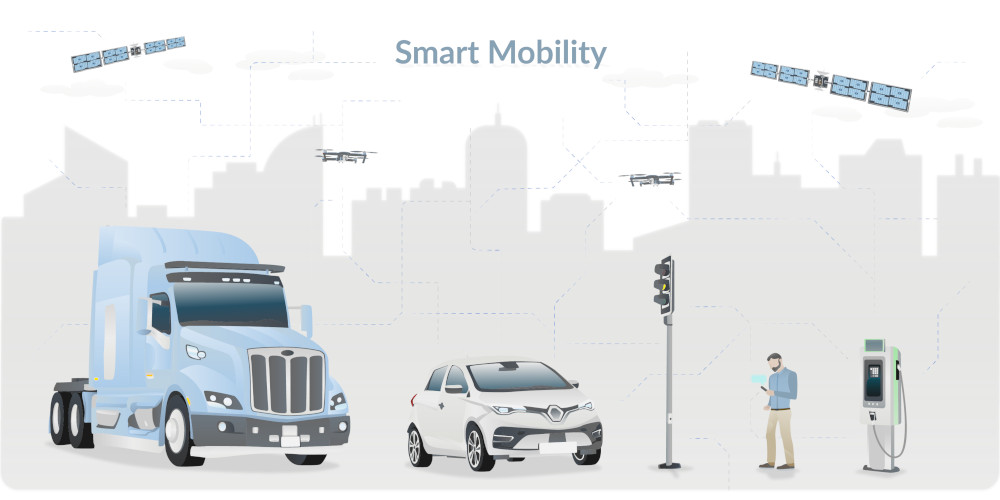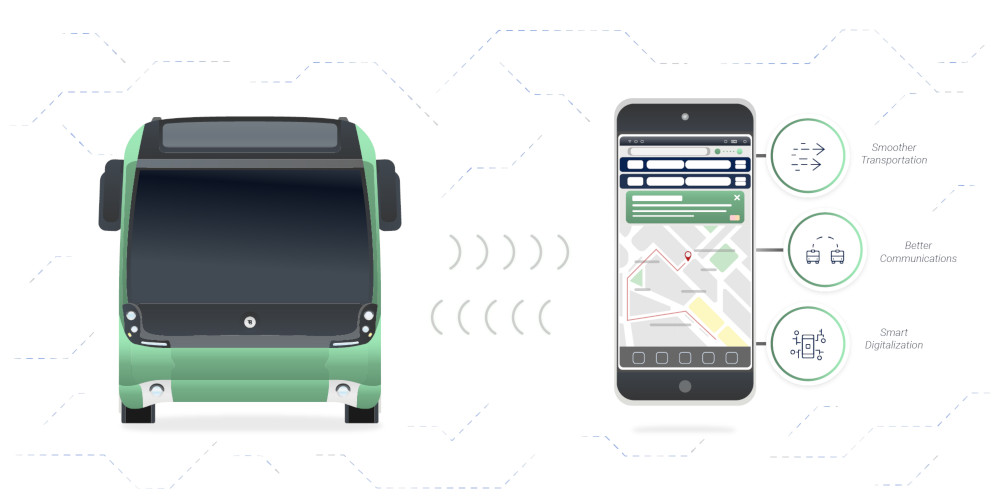The integration of digital technology into our transportation systems is rapidly advancing in 2023, leading us into the Smart Mobility era. This modern approach is transforming the way we travel, particularly in cities across the U.S. and around the world.
Smart Mobility Solutions go beyond trendy tech talk; they're a practical solution to the significant challenges we face today. Our cities are challenged by heavy traffic and pollution from traditional vehicles, and it's clear that a change is needed.
This is where Smart Mobility, with the rise of smart cars, electric vehicles and the application of telematics, comes in.
Keep reading to discover these!
What is Smart Mobility?
Smart Mobility is the seamless blend of diverse transportation methods with advanced technologies to create efficient, eco-friendly urban transit systems. In simple terms, it's about using tech to make traveling in and around cities more straightforward and greener.
At its core, Smart Mobility represents the complex connection of multiple modes of transportation, integrated with the latest technological advancements such as sensors, big data analytics, artificial intelligence (AI), and telematics. This fusion is the cornerstone for smart cities that are crafting innovative and sustainable ways to move people and goods.
Smart mobility solutions goes beyond simply improving traffic flow; it is about revolutionizing the entire ecosystem of urban transportation. By leveraging big data, cities can analyze patterns and optimize routes. Sensors and AI enhance the functionality and safety of vehicles, from cars to public transit, making them more responsive to the environment and user needs.
Telematics plays a crucial role by facilitating real-time communication between vehicles and transportation infrastructure, which is essential for the dynamic management of traffic and for providing critical insights into vehicle diagnostics and driver behavior.
Furthermore, smart mobility is integral to reducing carbon footprints, as it encourages the adoption of electric vehicles (EVs) and promotes shared mobility, reducing the reliance on fossil fuels.
As we move further into the 21st century, Smart Mobility is set to become the driving force behind more livable, efficient, and sustainable cities. It's not just about getting from point A to point B; it's about reshaping the urban landscape to foster a better quality of life for all citizens.

How Smart Mobility Works
Smart Mobility harnesses the power of technology to make transportation more efficient, sustainable, and convenient. Here's how it works:
-
Integration of Modes: It connects different transportation methods, such as buses, trains, and bikes, into a single, streamlined network.
-
Data Utilization: Utilizes data from various sources, including traffic sensors and user input, to understand and predict travel patterns.
-
Real-Time Adjustments: Leverages real-time data to optimize traffic signals, reduce congestion, and reroute public transit as needed.
-
Technology-Driven: Employs cutting-edge technologies like AI and IoT to improve the safety and efficiency of vehicles and infrastructure.
-
User-Centric Platforms: Provides platforms that allow travelers to plan and pay for their journey seamlessly across different modes of transport.
-
Sustainability Focus: Promotes the use of electric vehicles and non-motorized transport to reduce emissions and environmental impact.
Here are a few examples of smart mobility applications:
-
Traffic Management: Utilize real-time data and algorithms to update traffic signals, minimize congestion, and clear up traffic jams.
-
Public Transport Enhancement: Place public transit at the forefront, using intelligent systems and live data to make it more efficient and user-friendly.
-
EVs Promotion: Support the rise of electric vehicles, integrating them into city planning to lower emissions and promote sustainable transport.
-
MaaS Integration: Offer a 'Netflix-style' transport subscription, giving users access to various mobility options like car shares and bike hires on one platform.
Additional points:
-
Pedestrian and Cyclist Infrastructure: Improve walkways and bike lanes for safer, healthier urban travel options.
-
Smart Parking Solutions: Implement sensors and apps to guide drivers to available parking spots, reducing the time spent circling for space.
-
Integrated Payment Systems: Simplify fare payments across all modes of transport with unified digital payment solutions.
-
Data-Driven Urban Planning: Use mobility data analytics for informed decision-making on urban development and transport policies.
Smart Mobility is not just about technology; it's about creating a connected, sustainable ecosystem that caters to the evolving needs of urban dwellers.

Why is Smart Mobility Technology Essential?
Smart mobility technology stands at the forefront of modern urban development, offering a robust response to environmental concerns by reducing air and noise pollution.
It presents a strategic solution to relentless urban traffic, easing the daily commute with advanced, intelligent vehicles. As these vehicles become more integrated within our cities, the smart mobility market is set to grow, leading to breakthroughs in technology and new job prospects.
Smart mobility technology is custom-tailored, not a generic fix. It’s designed to be adaptive, serving the specific needs of diverse communities. In this advanced ecosystem, our roads are no longer mere asphalt strips but part of a dynamic, learning network empowered by intelligent vehicles that optimize travel in real time.
Real Life Examples of Smart Mobility Solutions
Across the world, cities are adopting smart mobility solutions to enhance transportation efficiency and sustainability. Let's explore some of them:
Smart Biking in Copenhagen, Denmark
Copenhagen has long been lauded for its bike-friendly infrastructure, but recent smart mobility solutions have taken this to the next level. The city introduced intelligent traffic signals that prioritize cyclists during rush hour, reducing commuting times. The result has been a surge in biking popularity, contributing to Copenhagen's goal of becoming the world's first carbon-neutral capital by 2025.
Autonomous Buses in Singapore
Singapore's commitment to smart mobility is evident in its trial of autonomous buses. These self-driving buses navigate designated routes using sensors and cameras. The implementation has optimized public transport routes, alleviating traffic congestion and minimizing wait times for commuters.
EV Charging Networks in Oslo, Norway
Oslo has an extensive network of electric vehicle (EV) charging stations, supporting its large EV population. Smart mobility technology enables real-time monitoring and management of the charging network, ensuring availability and efficient energy use. This network has significantly reduced the city’s carbon emissions and fostered a robust market for electric vehicles.
Integrated Mobility App in Vienna, Austria
Vienna has developed an integrated mobility app that combines public transport, car-sharing, bike rentals, and taxis into one platform. This one-stop-shop for transportation has simplified commuting in the city, leading to a decrease in private car use and a corresponding reduction in traffic volumes and pollution.
Traffic Management in Los Angeles, USA
Los Angeles has implemented a smart traffic signal system that adapts to traffic conditions in real time. By synchronizing traffic lights, the city has managed to cut down on delays by 13%, leading to a significant decrease in vehicle emissions and an improvement in overall air quality.
The examples we've explored demonstrate that smart mobility is driving positive change in cities worldwide, offering cleaner, more efficient, and smarter transportation options. These success stories highlight the potential for global transformation, inspiring a future where sustainable and intelligent mobility is not just a vision, but a reality.
Conclusion
In summary, Smart Mobility transcends the realm of theory to become the destined path of transport evolution. It is the intersection where artificial intelligence enhances road networks, where data informs driving decisions, and where environmental sustainability becomes an actionable strategy.
The ongoing fusion of cutting-edge technology with our city infrastructures assures us that Smart Mobility is far from a fleeting phenomenon — it is, unequivocally, the blueprint for tomorrow's urban transport systems.






